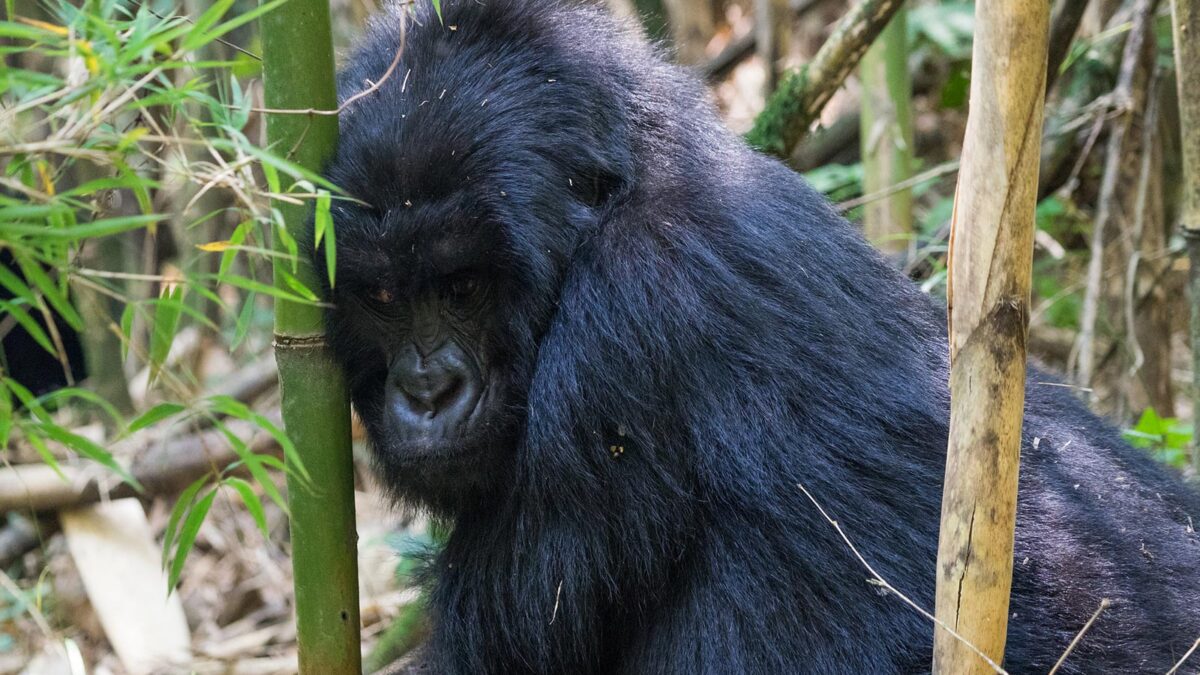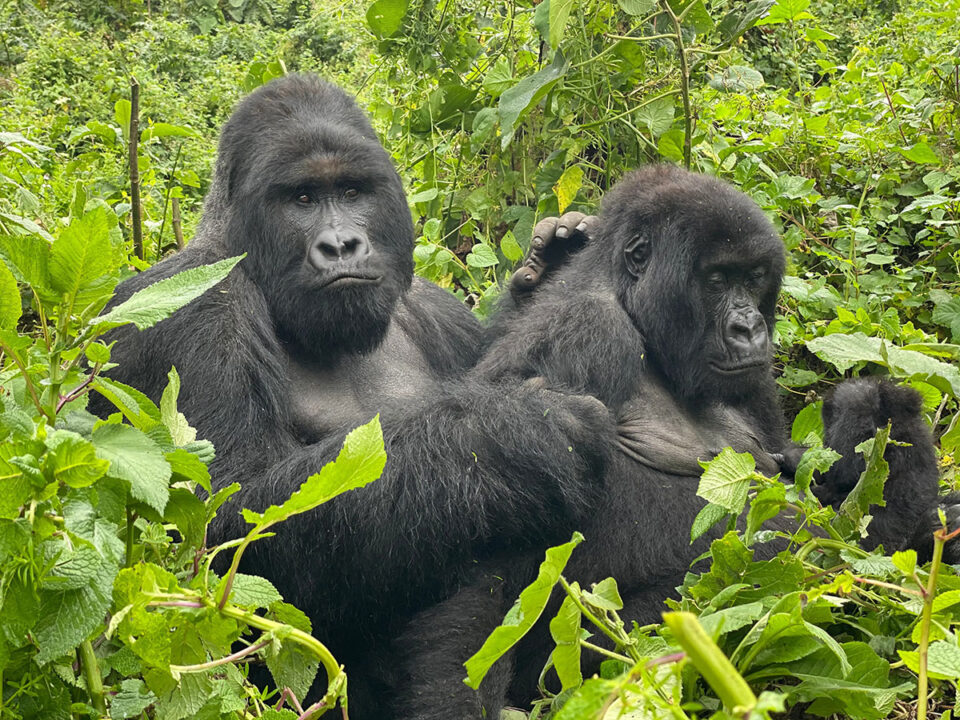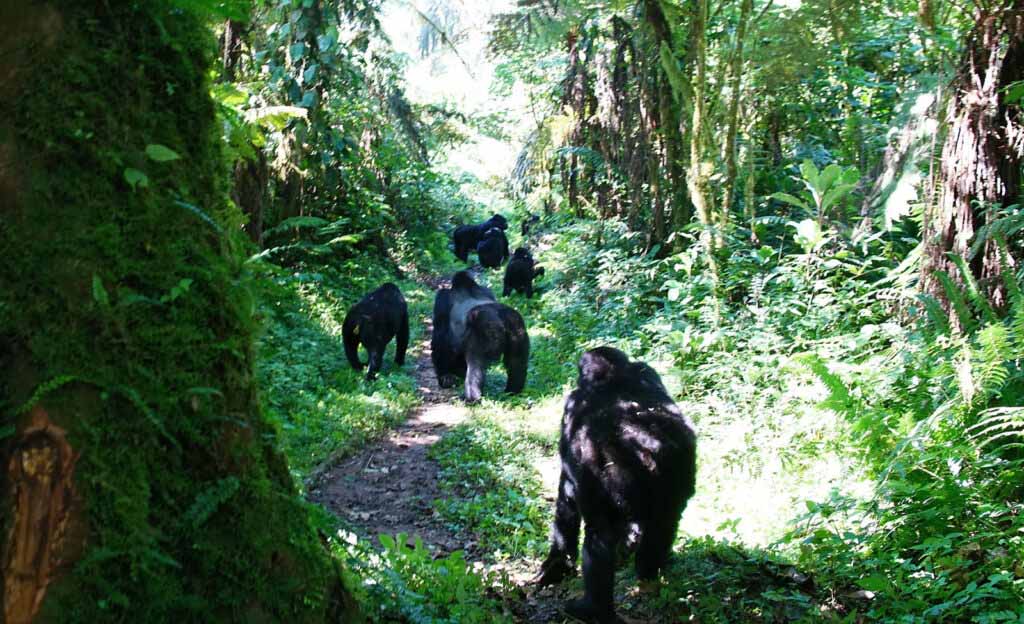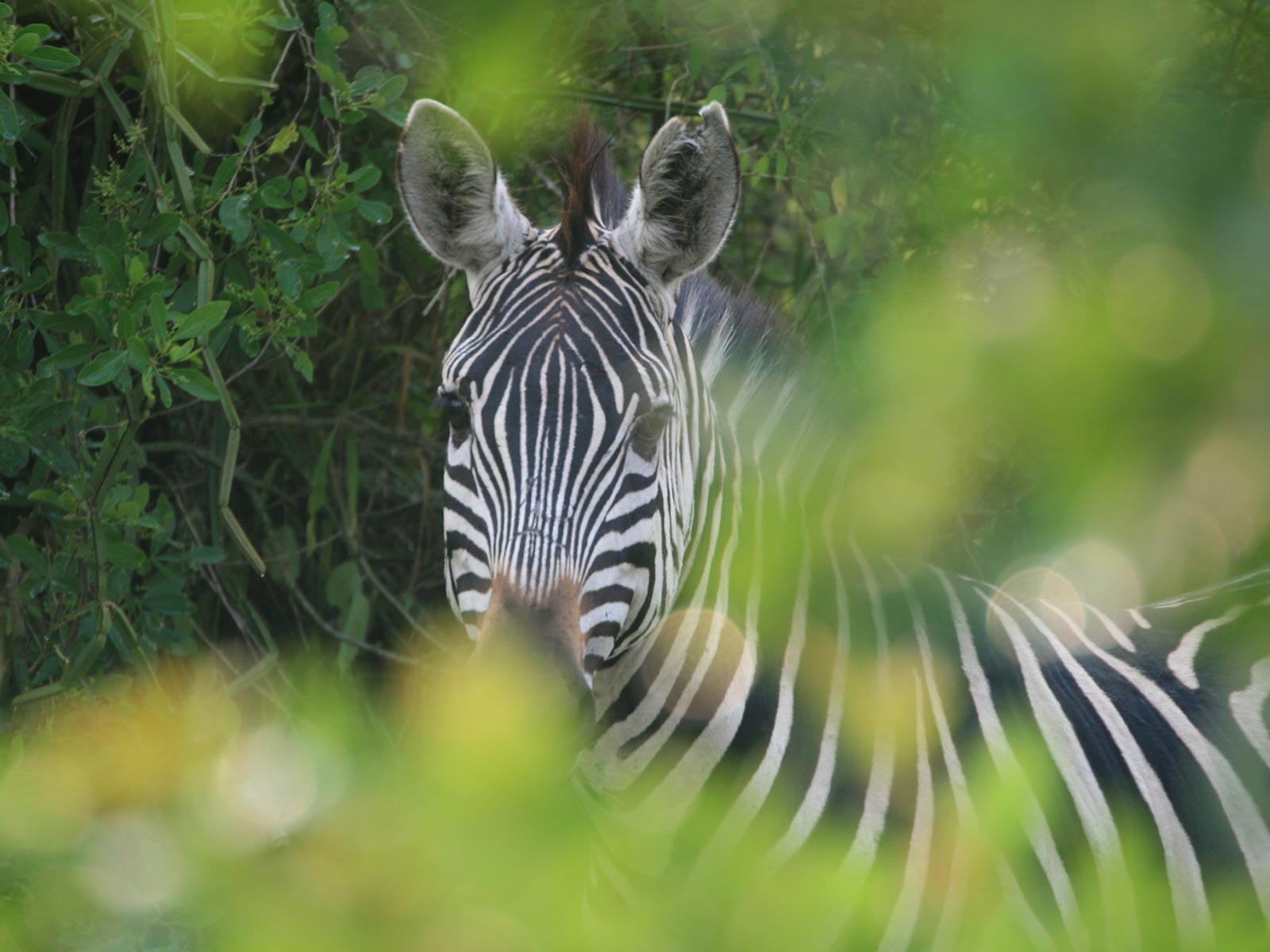Current Population of Mountain Gorillas in Uganda and Their Locations
Mountain gorillas are an extraordinary primate species and are among the most protected animals on Earth. They can only be found in their natural habitats, specifically in Uganda’s Bwindi Impenetrable Forest National Park and Mgahinga Gorilla National Park, as well as Rwanda’s Volcanoes National Park and DR Congo’s Virunga National Park. These national parks are geographically adjacent, facilitating coordinated conservation and protection efforts under the Greater Virunga Transboundary Collaboration. As a result, managing the well-being of mountain gorillas is made easier for conservation partners in all three countries.
Current Mountain Gorilla Population in Uganda
In Uganda, mountain gorillas are primarily located in two national parks: Bwindi Impenetrable National Park and Mgahinga Gorilla National Park. According to the recent census of mountain gorillas, the total population in Uganda, Rwanda, and DR Congo now stands at 1,063 individuals. Notably, the population in Uganda’s Bwindi Impenetrable Forest National Park, along with the nearby Sarambwe Reserve in DR Congo, has seen an increase from 400 gorillas to 459 gorillas. This positive trend indicates the success of conservation efforts in the region.
Locations of Mountain Gorillas in Uganda
In Uganda, mountain gorillas are divided into different groups within the four sectors of Bwindi Impenetrable National Park. These sectors include Rushaga and Nkuringo in the south, as well as Ruhija and Buhoma in the north. Each sector is home to multiple habituated gorilla families that can be visited by tourists, providing a unique opportunity for gorilla trekking experiences. Additionally, Mgahinga Gorilla National Park is home to the Nyakagezi gorilla group, the only habituated gorilla family in the park. It’s important to note that there are also unknown gorilla populations in the wild, further contributing to the overall gorilla population in Uganda.
Sector Details and Gorilla Families in Uganda
- Buhoma Sector: Situated in the northern part of Bwindi Impenetrable National Park, Buhoma is home to four gorilla families open for trekking: Rushengura, Katwe, Habinyanja, and Mubale. Buhoma holds historical significance as it was the first area where gorilla trekking was introduced in Bwindi back in 1993. Access to Buhoma can be made through Queen Elizabeth National Park and Lake Bunyonyi.
- Ruhija Sector: Located in the eastern part of Bwindi Impenetrable National Park, Ruhija is known for gorilla families such as Bitukura, Kyanguriro, Mukiza, and Oruzogo. This sector offers excellent trekking opportunities, with gorillas relatively closer compared to other sectors. Ruhija is also famous for birding and provides a chance to spot other primates and mammals, including monkeys and antelopes.
- Rushaga Sector: Situated in the southern part of Bwindi, Rushaga boasts eight gorilla families, making it the sector with the highest number of gorilla groups in the park. The terrain in Rushaga is comparatively easier for gorilla trekking when compared to Nkuringo and Ruhija, which have higher elevations. Gorilla families in Rushaga include Busingye, Bweza, Nshongi, Mishaya, Muchunguzi, and Kahungye. Additionally, Rushaga offers gorilla habituation experiences, allowing visitors to participate in the habituation process.
- Nkuringo Sector: Located in the southern part of Bwindi, Nkuringo is home to the Kuirngo and Christmas gorilla families, both available for gorilla trekking. This sector is known for its higher elevations, making it more challenging for trekking. Nkuringo is the closest sector to Rwanda, offering the possibility of a two-day trek with an overnight stay in Rwanda.
Frequently Asked Questions about Gorilla Trekking in Uganda:
What is gorilla trekking?
Gorilla trekking involves walking through the forest, following a designated trail, to search for and observe habituated mountain gorillas in their natural habitat.
Where can one see mountain gorillas in Uganda?
Mountain gorillas can be seen in Bwindi Impenetrable Forest National Park and Mgahinga Gorilla National Park.
Which is the best national park for visiting mountain gorillas in Uganda?
Both Bwindi Impenetrable Forest National Park and Mgahinga Gorilla National Park offer remarkable gorilla trekking experiences, with Bwindi being a tropical rainforest and Mgahinga characterized by bamboo vegetation.
How much does gorilla trekking cost in Uganda?
The cost of gorilla trekking includes the gorilla permit, transportation, guides, accommodation, and other services. A gorilla permit costs USD800 for foreign non-residents, USD700 for residents, and $70 for East African Citizens.
How long is a gorilla trek in Uganda?
Gorilla trekking typically takes 3 to 7 hours, depending on the gorilla group’s location and other factors. Once the gorillas are found, visitors spend one hour with them.
What is the maximum group size for gorilla trekking in Uganda?
Only 8 visitors are allowed to trek each gorilla family to minimize disturbance and reduce the risk of disease transmission.
Where can one purchase a gorilla permit in Uganda?
Gorilla permits can be purchased directly from the Uganda Wildlife Authority or through reputable tour operators like Trek Africa Expeditions.
Can elderly people visit and see mountain gorillas in Uganda?
Yes, elderly or disabled individuals can trek gorillas with the assistance of sedan chair carriers, which are available for hire.
Minimum Age Requirement for Gorilla Trekking in Uganda
In Uganda, the minimum age limit for Gorilla Trekking is 15 years, while there is no specific maximum age limit. The restriction on children below 15 years is in place due to several reasons. Firstly, the behavior of young children can be unpredictable and uncontrollable, which may cause disturbances during the trek and potentially disrupt the gorillas’ natural habitat. Additionally, children are more susceptible to diseases, including those that can be transmitted between humans and gorillas. To ensure the safety and conservation of both visitors and gorillas, the minimum age requirement is strictly enforced.
Best Time to See Mountain Gorillas in Uganda
Gorilla trekking in Uganda is available throughout the year, offering opportunities to encounter these magnificent creatures. However, there are certain periods considered as the best time for gorilla trekking. The recommended months include January, February, March, early April, and June to early September. During these months, the vegetation cover in the national parks is less dense, making it easier to spot and observe the mountain gorillas. Additionally, these periods experience fewer rains compared to April, May, and November, which can make trekking more challenging and uncomfortable due to muddy conditions. By planning your visit during the optimal time, you increase the chances of a successful and enjoyable gorilla trekking experience.
Essential Items to Pack and Wear for Gorilla Trekking
Proper preparation is crucial for a successful gorilla trekking adventure in Uganda. When packing for your trek, it is recommended to include the following essential items:
- Comfortable, hard-wearing walking shoes or boots: The terrain in the forest can be muddy and steep, requiring sturdy footwear.
- Long-sleeve cotton shirt and lightweight long trousers: These protect against the undergrowth, stinging nettles, and biting ants commonly encountered during the trek.
- Insect repellent: Helps protect against mosquitoes and other insects.
- Torch/flashlight with spare batteries: Useful for early morning treks or when returning in low light conditions.
- Wet wipes: Convenient for refreshing and cleaning during the trek.
- Water bottle: Stay hydrated during the trek by carrying a reusable water bottle.
- Camera and lenses: Capture memorable moments with the mountain gorillas and the beautiful surroundings.
- Gardening gloves: Recommended for gorilla tracking to protect your hands.
- Sandals or sturdy walking shoes: For comfort during breaks or when the terrain allows.
- Hat and sunscreen: Shield yourself from the sun’s rays during open areas.
- Rain jacket: Be prepared for unexpected rain showers in the forest.
- Sweater/fleece: The early mornings and higher elevations can be chilly.
- Comfortable walking/hiking boots and socks: Ensure your footwear provides adequate support and comfort.
- Swimwear: Some lodges may have swimming facilities for relaxation after the trek.
- Binoculars for bird watching: Enjoy observing the diverse bird species found in the national parks.
Accommodation Options for Gorilla Trekking in Uganda
During your gorilla trekking experience in Uganda, there is a wide range of accommodation options available to suit different preferences and budgets. These options include:
- Buhoma Lodge
- Bwindi Lodge
- Rushaga Gorilla Havens Lodge
- Rushaga Gorilla Camp
- Nkuringo Bwindi Gorilla Lodge
- Four Gorillas Lodge
- Bakiga Lodge
These accommodations offer comfortable lodging, a variety of local and international food dishes, Wi-Fi access, and convenient access to gorilla trekking activities. Whether you prefer budget, mid-range, or luxury options, there are suitable choices to enhance your stay and overall safari experience.
Benefits of Booking with Trek Africa Expeditions
Trek Africa Expeditions is a reliable and experienced tour operator that specializes in arranging gorilla trekking experiences in Uganda, Rwanda, and DR Congo. By booking with Trek Africa Expeditions, you can expect several benefits, including:
- Expert guidance and assistance in booking your gorilla trekking adventure.
- A variety of gorilla trekking safari packages tailored to different budgets and preferences.
- Assistance with securing gorilla permits, a crucial aspect of the trekking experience.
- Positive reviews and testimonials from a satisfied community of clients on platforms such as TripAdvisor.
- A commitment to providing excellent service and ensuring customer satisfaction.
- A dedicated team of knowledgeable tour consultants ready to answer all your safari-related questions.
- A guarantee of a memorable Uganda safari holiday, coupled with the opportunity to explore Rwanda and DR Congo.
Uganda is home to a significant population of mountain gorillas, with their habitats primarily located in Bwindi Impenetrable National Park and Mgahinga Gorilla National Park. The conservation efforts in these parks, along with the collaboration between neighboring countries, have contributed to the increase in gorilla populations. Gorilla trekking in Uganda offers a unique and memorable experience, allowing visitors to observe these incredible creatures up close while ensuring their conservation and protection.






